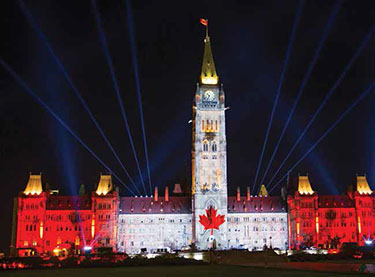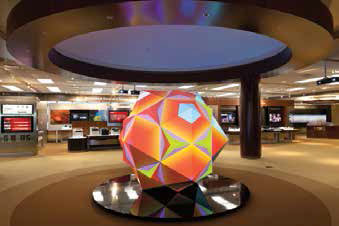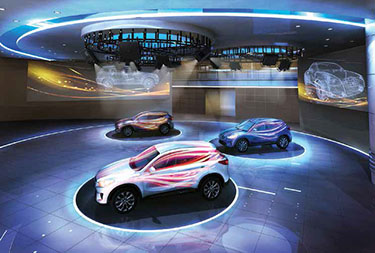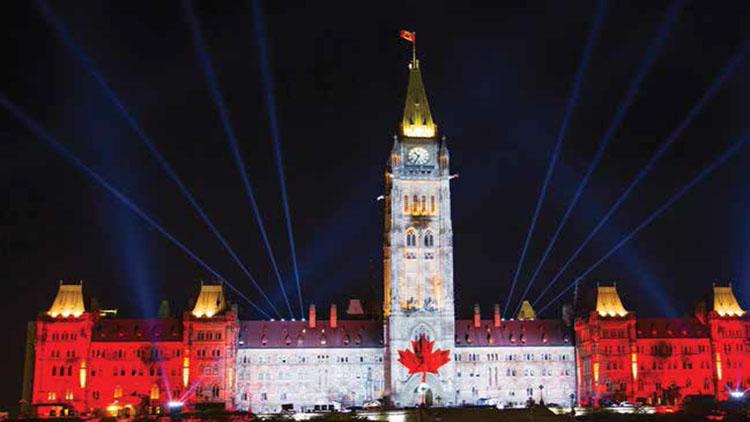Step right up, ladies and gents, to a huge opportunity courtesy of projection mapping—that colorful, eye-popping technology changing the face of digital signage by injecting a big dose of creative possibilities.
For one thing, it eliminates the need for traditional displays, said Jeff Hastings, CEO, BrightSign. “With projection mapping, it’s possible to display video content on flat surfaces such as walls, windows, and mirrors, but also on contoured surfaces such as buildings, statues, and other landmarks. This freedom is very liberating for creative professionals, as the world becomes their canvas, making it possible to engage viewers in virtually any setting.”

The Canadian Parliament building mapped by Christie projectors.
And projection mapping is offering both users and designers the ability to let their imaginations run free, noted Richard McPherson, senior product manager for projectors, NEC. “With other technology currently available on the market, content has been locked into a defined format with little to no ability to push the boundaries of what’s possible. Projection technology lets creative teams develop content in any shape to be displayed on the surface of their choice, creating more dynamic and eye-catching content.”
Think beyond the rectangles, said Curtis Mutter, senior solutions manager, Christie. “Projection mapping can be used to create a non-rectangular canvas providing unique creative opportunities for messaging. It can convert almost any space or surface into a digital canvas. Examples include building facades, cars, and unique architectural elements within retails spaces, etc.”
Pitch and Deliver
When projection mapping is an appropriate solution, integrators shouldn’t hesitate to offer this option to clients.
“Interactive projection mapping can be used as a tool to augment existing retail display spaces,” Mutter said. “For example, imagine using projection mapping on a shoe display where users can engineer their own colors and designs, and see them instantly projected onto the shoe.”
Projection mapping is an excellent complement to traditional signage, Hastings noted. “It works great in spaces where using traditional displays isn’t possible; but beyond that, projection mapping is an impressive way to capture interest in larger public spaces, generating awareness and excitement for the projected content.”

An installation using Canon projectors.
Show them, don’t tell them, advised Gregory Scalco, senior technical specialist, Canon USA. “Yes, you do have to tell them about it eventually, but if you can show an integrator the end result in a variety of forms, they will react in similar ways to that of a viewer, who is the intended audience. This is all predicated on your upfront understanding of the integrator’s objectives and the intended audience. One size definitely does not fit all.
Once you have gotten the client’s attention, he said, you may have to change their paradigms. “This is the opposite of projecting onto a flat screen, and they need to embrace the fact that any surface is a canvas to be fully utilized. It all begins with a creative idea that does not yet exist, and this becomes the motive or objective of a project. In other words, what does the end user want to accomplish? It should be thought of as visual sculpting with spatial art. Layers of light create the visual perception. In the end, illusion becomes reality. In a sense, it really is magic. What you see is not real but appears as if it is, as if you can reach out and actually touch it.”
A demonstration of projection mapping allows for the freedom to show images in any size and shape on any surface, McPherson emphasized. “Clients will be able to visualize the concept easily, aiding in the decision-making process. With traditional methods of delivering signage, there are limitations as to how large a demonstration can be, and it may even require the client to visit a predetermined location for a complete understanding of the concept. Projection can be brought to the client and demonstrated with the smallest projector while creating an impactful message.”
The NEC PX1004UL, he said, “is a powerful installation laser projector with a laser/phosphor light source that makes it perfect for all-new applications. With more consistent brightness, improved color fidelity, and tilt-free or portrait modes, this laser projector will deliver in verticals such as retail, simulation, and theme park installations. The laser module delivers 20,000 hours of virtually maintenance-free operations, reducing total cost of ownership.”
Show Me the Money
Projection mapping is surprisingly affordable, Hastings added. “Projectors can be purchased at a variety of price points, depending on the scope and scale of the rollout, and affordable BrightSign XD and XT players can be used in place of expensive image renderers and warping/blending boxes.”

Showroom of the future courtesy of Epson projectors.
Projection technology doesn’t limit the projected image to one particular shape or surface, McPherson said. “The design layout may provide for multiple surfaces and shapes to receive content from a single projector. Utilizing a lower number of devices to develop and deliver the message makes projection a more affordable option over traditional formats used to date.”
In terms of cost, it’s a difficult question, Mutter cautioned. “Mapping projects can vary in scale and complexity; think mapping a shoe versus a building facade. The environment also factors in, as does the amount of ambient light, and the ability to control that ambient light, which can impact the amount of projector brightness required. Tools like Christie Mystique can help accelerate the design and deployment of projection mapping projects.”
No longer can the AV integrator rely on the hardware side of the business to generate adequate profits, Scalco explained. “Due to an ever-increasing commoditization and price decline of things an integrator buys and sells, it necessitates looking to all the ancillary services that surround their efforts to support their business model. There is the needs analysis phase, design effort, project management, integration, testing, training, and the ever-popular, service after the sale or maintenance contract.”
None of these should be considered commodities, and, if properly presented, they create the value-added condition that makes our business lives worthwhile,” he continued. “For those with the vision, you can add projection mapping services to the mix. The investment in hardware and software is reasonable and the major investment is in the creative person who will actually design the projection mapping. Under the heading of thinking outside of the box, this service can be outsourced effectively until your business will support a full-time projection mapping artist. The point is that this is a profit center that will maintain its value to the bottom line in the face of all that commoditization. In the end, it becomes yet another way to differentiate one integrator from another.”
Scalco recommends the Canon REALiS WUX500ST Pro AV LCOS Projector. “This addition to the Canon projector lineup combines a lightweight and compact design with a high brightness of 5,000 lumens and high WUXGA resolution. The REALiS WUX500ST can be outfitted to match a variety of installation environments, which can be achieved with the 0.56:1 short throw ratio and extreme lens shift of 0-75 percent vertical and 10 percent horizontal. This flexibility is further enhanced with HDBaseT, which allows uncompressed HD video, audio, and control signals to be transmitted seamlessly.”
The series exhibits great depth of field in its optics, which is so important, especially in warping applications to keep edge-to-edge focus, he said. “Demonstrating this feature and other optical enhancements will surely create a buzz with clients.”
Make It POP!
Don’t forget that projection mapping is ideal for pop-up installations, Hastings noted. “Traditional displays aren’t required, and projectors make it possible to project onto virtually any surface. And rear-projection makes it possible to create imagery on translucent or transparent materials, with all technical components hidden from sight.
“We’re also beginning to see projection mapping used extensively in museums to add an element of interactivity to prominent exhibits,” he added. “Museums often carefully control light levels to create the desired ambiance and to limit exposure to UV light; this creates a controlled environment that’s ideal of the projected imagery.”
Karen Mitchell is a freelance writer based in Boulder, CO.
The How and The Wow
People are on visual overload these days, and even a very large, dramatic LCD display doesn’t stop them in their tracks, according to Ramzi Shakra, product manager, large venue projectors, Epson America. “But projection mapping has a WOW factor and will make people stop and engage a lot more. A good example is mapping used on a mannequin at the entrance to a store, using one or more projectors to map the mannequin with a swimsuit and then a coat in various colors.”
Projection mapping has not yet reached the point where most people are generally familiar with the technology, although they may run across it in architectural mapping or projected on a car at an auto show, for example. “Integrators shouldn’t expect all clients to know much about projection mapping; it’s really up to the integrators to educate themselves before presenting it to clients,” he explained.
Integrators need to realize mapping is not a one-stop solution, Shakra advised. “It’s more complex and involves content and creative elements. There’s mapping software, determining the number of projectors needed, and their placement in relation to those objects to consider for any project. There are a lot of factors, and an integrator needs to be proficient and bring in the necessary partners, if not available in-house, to flush it all out.”
